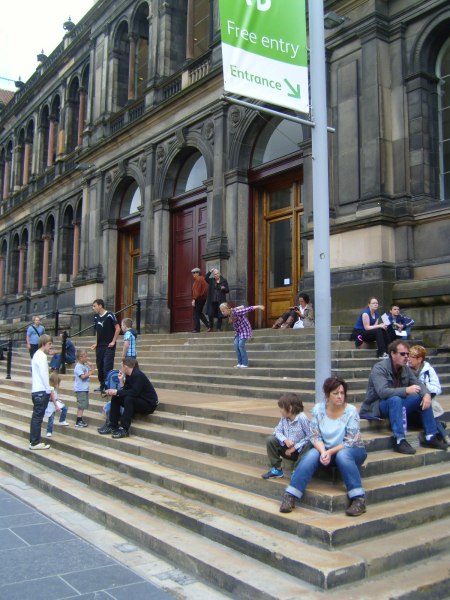
The “No Photography” sign. It’s so ubiquitous that even when I don’t see a sign, I’m still wary that if I whip my camera out a stern-looking security guard will materialise to have words. ‘No photographs’ is still the default setting in many museums and most galleries, to the extent that when the ban is mostly absent, as it is in GoMA, it brings a markedly different complexion to the exhibition environment.
Not all exhibitions are so censorious of photographic activity – indeed, in one of the first exhibitions I worked on, at the National Space Centre in Leicester, some exhibits were deliberately planned to work as photo opportunities. Generally speaking, hands-on exhibitions and venues that target families seem to welcome photography as an important way for their visitors to record, share and recollect experiences.
A quick tot-up of my ‘Exhibit Photos’ file folder revealed some 3000 images of exhibits and exhibitions, in approximately 20 cities around the world, all taken since I first bought a digital camera back in 2003. For me, this is a valuable repository of all the places I’ve visited; the good, bad and ugly of exhibit ideas; and a way to remember far more than if I’d travelled with just my eyes, ears and unaided memory. Just looking at the pictures brings back the experiences, and I remember far more about what I did, how I felt and what I learned at all the exhibitions I’ve been fortunate enough to have visited. Without these images, most of these experiences would have been lost in the blurry mists of time.
Admittedly, the purpose of my photographic jaunts was primarily professional (and the emphasis of each batch of photos is an inadvertent record of whatever particular kind of exhibition I happened to be researching at the time – it inevitably influenced what was ‘photo-worthy’). Even so, compact digital cameras (and more recently smartphones) have transformed photography from a way of documenting holidays and special occasions to the way we increasingly document and share our day-to-day lives. We see, therefore we photograph. We photograph, therefore we share. These actions help to reinforce our memories and add value to our experiences. But have museums recognised this cultural shift? And are they doing anything to accommodate it?
The photography ban is based on some sound reasoning. However, I want to deconstruct some of this reasoning to see if it still holds in the 21st century, or whether museums and galleries are simply sticking to historical habit to the detriment of the visitor experience:
- Conservation reasons: Light damages delicate objects like paper and textiles. Their ideal environment from a conservation perspective is complete darkness, so having sensitive objects on public display at all is always a matter of compromise at some level. So banning flash photography makes sense. Non-flash photography may be impractical (although not damaging) as the objects are often displayed in low-light environments. However, while it depends on the objects of course, I wonder if the ‘no flash’ rule is applied more liberally than it needs to be, given that modern camera flashes are nowhere near as UV-intensive as the old-fashioned ones that the rules were presumably designed for?
- Pointless or disruptive photography: in these circumstances, banning photography makes perfect sense. Other people snapping and flashing away (in the photographic sense) can inhibit the experience of other visitors, particularly during shows or theatrical presentations. One person’s right to document their day shouldn’t trump the rights of other visitors to enjoy the experience in peace if they so wish. Live animals displays are also an inappropriate subject for flash photography. A final note in this regard, I always have to have a bit of a giggle to myself when I see people attempt to take a flash-photograph of a projection. Do they really not realise that all they are capturing is a blank screen?
- Copyright reasons: this is the big one. And by far the knottiest. It sounds serious, but at the same time is sufficiently vague that it can seemingly be used as a convenient excuse to point to in order to stick to the comfort zone of the status quo. This is a cynical interpretation, to be sure, but visitors are seldom given any evidence to counter such cynicism. Sometimes it seems as if copyright is too complicated to figure out; that it’s easier for museum and gallery management to just lump everything together into the intellectual property equivalent of the maximum security wing. Looking at society more broadly, the copyright genie is well and truly out of the bottle – attempts to bring it back under old business models seem doomed to failure (the recording industry and rights management is a salutary tale here). In any case, I find it hard to understand how a few iPhone snaps in a gallery pose a serious copyright threat to anyone: people will still want to buy properly produced prints and postcards of the items they really like, and how can the extra publicity generated by the sharing of photos be a bad thing for artists’ careers?







